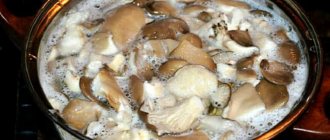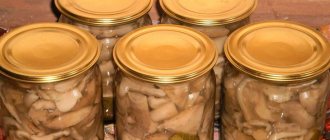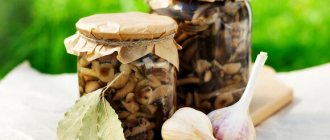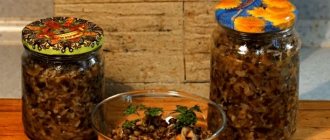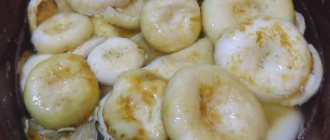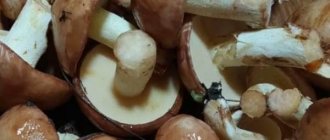Homemade preparations have always been welcomed by housewives. To this day, they are an indispensable attribute not only on the holiday table, but are also ideal for an everyday dinner.
Despite the variety of canned products on supermarket shelves, homemade pickles leave no one indifferent. Homemade canned food not only has an excellent taste, but is also rich in vitamins that are so necessary for humans.
There are many recipes for preparing various canned foods. During the cold months, berries and mushrooms collected in the summer months are popular. But it will be possible to enjoy their great taste only if certain rules are followed, the implementation of which is a necessity for all types of preservation.
Beginning housewives must first become familiar with the various methods and some nuances, so that even if they make minor mistakes, they will know what to do if a jar of mushrooms swells, if mold appears, or if the color of a particular product changes.
Why do banks explode?
Now we will find out the main reasons why rolled up jars of mushrooms become bombed: • poor washing of mushrooms before rolling; • non-compliance with the exact recipe. Especially if you add little vinegar; • poorly sterilized and washed jars. In this case, there may be microbes on the surface of the cans, which in the future will become the main cause of undesirable consequences; • poor-quality closure with lids or poor rolling of iron lids. As a result, air enters the can, which is the main cause of the explosion; • canned jars of mushrooms are kept warm, which is absolutely not allowed.
Signs of botulism in canned food
Ordinary preservation and preservation contaminated with botulism are no different, which is a rather dangerous factor. The bacteria does not manifest itself in any way: not externally, not by smell, not by taste. Only laboratory tests can accurately determine the presence of a toxin.
Still, you can recognize botulism in a jar at home. It often happens that the liquid in the jar becomes cloudy and bubbles form. But bacteria don't always behave this way. Perhaps the only sure sign of botulism in a jar is a swollen lid. Such products must be thrown away immediately!
So how can you determine the presence of botulism bacteria in canned food? Signs of botulism in canned food are a swollen jar and the formation of bubbles.
It is important, when the expiration date expires, to immediately get rid of canned food!
What canned foods may contain botulism?
- The development of botulism in tomato juice is unlikely, since this juice has a low pH level.
- It is necessary to clean mushrooms especially carefully, because quite a lot of microbes remain on them. Next, be sure to process and marinate the mushrooms by adding vinegar.
- Jams should also be taken seriously.
- You also need to be careful with purees and preserves that have not undergone heat treatment (berries and fruits ground with sugar). At the slightest sign of gas formation, you need to throw away such a product.
How to avoid exploding mushroom jars
We have listed the main reasons for can explosions. Now let's look at how you can avoid such undesirable consequences. If the problem is sterilization, then it is necessary to sterilize already filled jars. You can simply put them in the oven and heat them to 100 degrees. After about 15 minutes you can close them with pre-sterilized lids. You should also remember that peppers and mushrooms are considered the most finicky foods. Therefore, such preparations need to be given special attention. When canning fried chanterelles, for example, you need to spare no oil. They must literally swim in it. Otherwise, there is a very high probability that the banks will swell. After you have closed the lid of the jar, make sure that it fits tightly and that there is no free space left. Also, special attention should be paid to the seaming machine. If it is old or simply rolled up poorly, then air may get in, which will subsequently be the main cause of the explosion. If your jar of mushrooms exploded because it was in a warm place, then next time you need to be sure to put all the jars in a cool place. The ideal option would be the following: for the first two days, put the jars in the refrigerator.
Sterilization of jars and lids
To prevent bombing, you should adhere to the holding time of jars and lids during sterilization. Unlike sterilization for vegetable preparations, mushroom pickles require longer aging. The jars are placed in the oven for 15 minutes, and the lids are boiled in water for 12-16 minutes.
Why did the jar of mushrooms swell? What to do if a jar of mushrooms swells?
If this happened, then probably the jars were simply poorly pasteurized, which means some microbes remained. It will simply be unpleasant to eat such products later. There is one more nuance. If a jar of mushrooms “exploded” just a few hours after seaming, then they can be re-rolled. To do this, you need to re-sterilize the jars, then transfer all the contents and boil well. After all, mushrooms are a product that must be eaten very carefully. Especially if they have already been processed.
Well, if a lot of time has passed since the explosion, then it is better to throw them away immediately. After all, health is much more important.
.
A few facts about botulism in canned food
- Botulism is a fatal disease, but if you consult a doctor in time, you can quickly get rid of this bacterium.
- This is a non-contagious disease. You can only become infected by eating a contaminated product.
- Botulism is a rare disease. You shouldn’t panic and give up your favorite home-canned food, but it’s better to be careful.
- You can find several new recipes on the Internet. Now there are many new ways of processing food, but do not forget about “grandmother’s” recipes, because the older generation knew many secrets on how to protect themselves and their family.
- The initial symptoms of the disease are similar to many other diseases, so laboratory tests are necessary. This means that if a person feels a certain discomfort, it is better to immediately go to the hospital, since the disease is quite serious.
You just need to be more attentive to your health, and you can enjoy your favorite pickles without harm to your health.
What to do if mold has already appeared
Considering that mold is omnipresent, experienced housewives know how to deal with its manifestations. You shouldn’t throw away mushrooms, but leaving them to chance is not the right decision, since both the taste and smell of the delicacy will suffer. Therefore, as soon as you notice the slightest mold, you need to take a number of measures:
- Find out the extent of the damage.
- If mold is visible only on the surface of the mushrooms and brine and has not penetrated deeper, then carefully remove the top layer of mushrooms and drain the old brine, wash the rest, bring to a boil, and drain the water. The jars are sterilized again, into which the mushrooms are then placed, sprinkling the layers with salt (the mushrooms will not take excess) and filled with a new, non-boiling saline solution.
- If the mold has penetrated deeply and there is a persistent musty odor, no matter what you do, it will not go away. Therefore, without regret, it is better to throw everything away completely. Remember that if you eat mushrooms with mold, you risk getting poisoned.
- Add spices: cloves of garlic, sprigs of dill with seeds, horseradish leaves.
- Disinfect the weight, flap, wooden circle or plate that is placed directly on the salted mushrooms. To do this, rinse them thoroughly in warm water, then scald with boiling water. After that, install everything in its place.
- Store and maintain the temperature range from 4 to 6°C.
- Every week after storage, carry out the following sequence of actions:
- remove the weight, plate or wooden circle and drain the top brine;
- pour clean water and drain again;
- Be sure to wipe the top edges of the dishes. To do this, you can use a clean cloth soaked in vinegar;
- pour fresh saline solution (1 tablespoon of salt per 1 liter of water) and place the weight in place, having disinfected it in advance and what it stands on.
Recipes for porcini mushrooms
How to cook dried porcini mushrooms? They are usually dried whole, so before cooking they are usually soaked, then squeezed and cut into pieces. A popular dish in Russian cuisine is cabbage soup, to which tasty and aromatic boletus mushrooms are added. The classic recipe looks like this:
- The soaked mushrooms are washed and chopped.
- Then they are filled with clean warm water and brought to a boil.
- After half an hour, salt and spices (bay leaf, pepper) are added to the broth.
- Next, you need to finely grate fresh carrots (1 piece), cut the onion into rings (1 medium-sized piece), and potatoes (5-6 pieces) into small slices.
- Add chopped potatoes to cabbage soup, sauté carrots and onions in olive oil.
- After 10–15 minutes, add 250–300 g of fresh or sauerkraut.
- After fifteen minutes of cooking over low heat, the cabbage soup is completely ready.
Try to prepare a delicious, but at the same time quite affordable recipe, which involves dried porcini mushrooms - pasta with aromatic boletus mushrooms. For cooking you need pasta made from durum (durum wheat). Pre-soaked mushrooms are fried, then mixed with paste and served along with herbs.
No less popular is the sauce with the addition of broth, which remains after boiling the boletus mushrooms. The following seasonings are used to prepare the sauce: cloves, pepper (black peas) and thyme.
Harvesting mushrooms
Particular attention should be paid to storing mushrooms for the winter. With proper preparation, they can be stored for as long as possible and will be a great addition to dinner.
Before sealing, already filled jars with lids should be sterilized. They are sterilized in water heated to 40 degrees for about 40-50 minutes. If the water manages to boil away during this time, then you need to add boiling water, otherwise the temperature difference will cause the glass jar to burst. Next, you should immediately seal it, check the quality and then cool it at room temperature.
If the rules are not fully followed, this will lead to spoilage of the canned food, and all housewives will have to face a common problem, who subsequently do not know what to do if the jar of mushrooms is swollen or the lid comes off completely.
How to test for botulism?
If such a nuisance does happen and a marriage occurs, then you need to know what to do and what to do if the jar of mushrooms is swollen. Before the product is reprocessed, the formation of botulism must be determined. You should press on the swollen lid. If it is dented, then a new washing and digestion of the mushrooms is allowed, and if the lid does not dented, then the process of botulism has definitely begun in the jar, and in this case it is necessary to throw away all the contents. This product will no longer be suitable for use.
But it should be remembered that mushrooms are a product whose consumption requires special care.
Processing methods
How to remove bitterness from mushrooms? We remove the bitter taste by processing - soaking or boiling. There are no other ways or means to remove bitterness. The collected mushrooms should be cleaned, divided by variety, so that each type is soaked or boiled separately. For russula, the colored film must be removed from the cap.
Different types of mushrooms are soaked and boiled in different ways and require different times. But after preliminary preparation, you can cook - salt, fry, marinate - they can be combined.
Both soaking and boiling mushrooms is a long process. Soaking lasts two days, with water changes 2-3 times a day. At the same time, you can taste the mushrooms - for some, the bitterness disappears earlier. If it is no longer there, you can use the mushroom for further cooking. To speed up the process, you can slightly salt the water in which the mushrooms are soaked with non-iodized salt. 1 liter of water will require 10 grams of salt; it absorbs bitter substances well. Place the container with soaked mushrooms in a dark, cool place so that they do not spoil.
The soaking time varies for different mushrooms. So, russula and saffron milk caps are not soaked at all, white milk mushrooms and milk caps are soaked for 1-1.5 days. Seryanka, valui, gladysha, black milk mushrooms, podoreshnik, whitefish, violins are soaked for two to five days. Moreover, in each area, in different weather conditions, the soaking time is also different, so you should listen to the advice of local mushroom pickers.
Boil the mushrooms several times for 15-20 minutes, changing the water. You can also taste them during the process and continue boiling until the taste becomes normal. Generally, boiling removes bitterness faster than steeping.
If mushrooms are bitter even after processing, it is better to throw them away so as not to poison yourself and your loved ones. You can also spray them with citric acid, but is it worth the risk?
The water for soaking and boiling mushrooms should be clean, spring, well or filtered. Do not use chlorinated tap water.
Chanterelles, which contain a lot of bitter substances, can be washed with running water and then sprinkled with flour, it will absorb the bitterness. After 15 hours, they are washed again and tasted.
The milk mushrooms are boiled several times, replacing the water. They need to be boiled until the water remains clear, this will indicate that the bitterness has disappeared.
Bitter mushrooms can ruin the taste of the dish!
Secrets of pickling mushrooms for the winter
What could be tastier at any holiday table than strong pickled mushrooms? Rarely does a Russian table go without them. And although you can always find dozens of pickled mushrooms of different appearance and taste on store shelves, every housewife strives to make mushroom preparations with her own hands. Because, let’s be honest, such mushrooms are tastier, dearer, and healthier!
- White mushrooms
- Boletus
- boletus
- Butter
- Mokhoviki
- Honey mushrooms
- BBW
- Rows
- Chanterelles
- greenfinch
- Kozlyaki
- Saffron milk caps
- Russula
- Champignon
- pigs
- Valui
Of course, for pickling it is best to take tubular mushrooms, especially young and small ones, but lamellar mushrooms, if handled skillfully, turn out “masterpieces.”
But today we’ll look at how to properly approach this serious and important procedure - preparing pickled mushrooms for the winter, and how to make not just an appetizer, but a dish that friends and family will be the first to “sweep away” from the holiday table and ask for more.
In order for pickled mushrooms to turn out tasty, beautiful and healthy, they must go through several stages of processing.
Sorting
All mushrooms brought from the forest must be sorted by type and size. Why? Because each type of mushroom has its own characteristics, taste, smell, “appearance”, each type has its own digestion time. And, for example, identical small mushrooms will look much more beautiful on the table than an assortment of different sizes on one dish.
This stage is not required for all mushrooms.
- — If the mushrooms are very dirty, you can make cleaning them easier by soaking them in salted water for a short time.
- - For example, if honey mushrooms are soaked in strongly salted water for 1 hour and then rinsed under a strong stream of tap water, they will be perfectly cleaned of dirt and debris, which will save you a lot of time and effort.
- — Valui and svinushki must be soaked in cold salted water for 2 days before pickling, changing the water every 10-12 hours.
- - Apart from milkweeds, mushrooms should not be kept in water for a long time - they will absorb excess water, which is not very good for subsequent processing.
- visual disturbances – double vision, “spots”;
- drooping lower eyelid;
- shortness of breath, difficulty breathing in and out;
- increasing weakness;
- dizziness;
- weakness of the neck muscles, inability to hold the head straight;
- difficulty trying to move your tongue;
- lack of facial expressions;
- involuntary urination;
- bloating.
Dried mushroom poisoning: symptoms
The most common cause of poisoning is eating dried poisonous mushrooms. Inexperienced mushroom pickers may confuse chanterelle or boletus with toadstool and then poisoning cannot be avoided. After heat treatment or drying, poisonous mushrooms still remain dangerous to humans.
Causes of poisoning:
- Mushrooms were collected near highways and chemical plants;
- Symptoms of poisoning often occur in people suffering from chronic diseases of the gallbladder, gastrointestinal tract, kidney and liver failure;
- Poor quality raw materials for drying;
- Violation of the technology for preparing products for the winter.
Symptoms of intoxication
Signs of poisoning become noticeable a few hours after using dried mushrooms for food. The severity of the clinical picture depends on the age of the victim, body weight, and the amount of delicacy eaten. General symptoms of poisoning by boletus and boletus are similar to signs of food intoxication.
Dry mushrooms
However, despite the benefits, mushrooms also pose a considerable danger to the body. They are difficult for the stomach to digest and their nutritional value is extremely low. At the same time, experienced lovers of “silent hunting” know that the caps contain less fiber, and therefore are easier to digest than the legs.
Nutritionists believe that the body best absorbs dry mushrooms in the form of ground flour.
For example, if you can’t imagine your diet without mushrooms, then you can’t think of a better way to consume them, like adding them to the dough for baking pancakes. Store the powder in a closed glass jar with the lid tightly closed. For long-term preservation, it is recommended to add a small amount of non-iodized salt to the flour, since iodized salt kills the taste and aroma of the product.
Despite the fact that drying is considered the safest method of harvesting, some nuances should be taken into account in order to avoid unpleasant consequences - poisoning and eating disorders.
Firstly, dry mushrooms contain fungin, a substance that puts additional stress on the liver. For this reason, doctors do not recommend using the product more than twice a week, and young children should not be given it at all, at least not earlier than 7 years of age.
So, drying is one of the safest cooking methods, so when going on a “quiet hunt”, think in advance what you are going to do with the harvest.
How to properly dry mushrooms
Each housewife has her own way of drying mushrooms, with which she manages to preserve the aroma and taste of the delicacy. Before you start harvesting, you need to know which types of mushrooms can be dried and which cannot.
Tubular mushrooms
Many members of this family are suitable for dry harvesting.
Types of mushrooms:
- Boletuses;
- Butter;
- White mushrooms;
- Boletus mushrooms;
- Moss flyers.
Lamellar mushrooms
Lamellar mushrooms are distinguished by long stripes under the cap and secreted white juice when cut. It is this liquid that gives the dried fruits of the forest a bitter taste.
Kinds:
- All varieties of honey mushrooms;
- The umbrella is motley;
- Champignon.
Volnushki, milk mushrooms and russula are not suitable for this type of preparation for the winter.
Chanterelles
Chanterelle is used for drying for the winter, but it has a specific bitter taste.
Marsupials
A distinctive feature of the marsupial fruits of the forest is a wrinkled, bumpy surface, unattractive in appearance. The most famous representative of this family are morels. They contain many toxins that, if improperly processed, cause food intoxication.
Another representative of the marsupial mushroom family is the white truffle. This forest product grows only in certain places and is rarely found by mushroom pickers.
Rules for drying mushrooms:
- First, forest gifts must be freed from dirt and leaves.
- Then you need to select mushrooms that are similar in size. Large fruits are cut into several parts; the legs of chanterelles and honey mushrooms are cut off.
- Wormy, rotten and overgrown mushrooms are not suitable for harvesting.
Methods for drying mushrooms:
- In the sun. Harvesting requires only dry and sunny weather. The fruits are strung on a string and dry for about a week. It is recommended to cover the top with gauze to prevent dust and flies from settling.
- In the oven. For drying, it is advisable to use wire racks; if they are not available, the baking sheet is covered with parchment paper. Dry for at least 8 hours at an average temperature of 60 degrees.
- In the microwave. This is a troublesome process, but some people still use it. At a power of 100 W, the mushrooms are dried for 15 minutes, then the microwave is ventilated and the procedure is repeated 5-6 times.
- In an electric dryer. The sliced product is laid out at an equal distance from each other and dried according to the instructions.
A properly dried mushroom is elastic, without burnt barrels, and moderately dry.
Why does botulinum toxin appear in mushrooms?
The disease is caused by bacteria of the genus Clostridium. In nature, it lives in soils, so it can easily end up in a mushroom picker’s basket. But it is not the bacterium itself that poses a danger to humans, but the neurotoxin it produces. This requires a special environment - a temperature in the range of 30–35 degrees and the absence of oxygen. The human body is optimally suited for these purposes.
Botulinum toxin is one of the most toxic compounds of natural origin. During World War II, the possibility of its use as a chemical weapon was repeatedly considered.
A distinctive feature of botulinum toxin is its resistance to environmental factors. It is not afraid of exposure to caustic alkalis and acids, frost, heat and ultraviolet rays. Botulinum toxin is not destroyed upon contact with gastric juice. Once inside along with food, it blocks nerve impulses, disrupting cellular metabolic processes. This leads to complete relaxation of the muscles.
The neurotoxin begins to act in the oral cavity, then moves through the digestive tract and enters the blood. Due to the systemic blood flow, it reaches the spinal cord and medulla oblongata, causing spontaneous paresis and paralysis.
Rules for storing salted mushrooms
To minimize the risk of mold forming on mushrooms, they must be stored properly.
Cold salting requires at least 40 days to complete the process. At the same time, immediately after you have poured the salt solution over the mushrooms, they need to stand at room temperature for 2-3 days for the fermentation process to begin. Only after this they are sent into the cold.
The temperature should be stable: from 4 to 6°C. Then the process goes as expected, and the pickles do not become moldy.
Traditionally, milk mushrooms and trumpet mushrooms are salted in a cold way. At the same time, salting chanterelles or saffron milk caps may require very little time: 5-6 days. That's why they are immediately placed in a cold place.
Mistakes when canning
The most common mistake is insufficient sterilization, which subsequently contributes to the development of microbes in the product. As a result, gas will begin to be released over time, the presence of which leads to an increase in pressure in the container.
Another factor that influences lid bloating is its quality. Air may get trapped at the junction with the can, as a result of which swelling should also be expected.
And if the lid on a jar of mushrooms does swell during storage, then further storage of the product is not recommended, since this indicates poor quality of the contents. Typically, this phenomenon can be observed within a few days after sterilization.
Basic Rules
Prohibited:
- Keeping canned foods in warm places. A sufficiently high temperature stimulates various chemical processes.
- Storage on an uninsulated balcony. When frozen, the volume in jars increases, which can cause glass containers to crack. Jam or preserves quickly become sugary in the cold.
- Storage for too long. Over time, slow chemical processes will begin to occur that will affect the quality of the products.
Recommendations:
- Store for no more than two years.
- Maintain the desired temperature from 0 to + 15 ° C.
- Use only sterilized utensils.
- Rinse all products thoroughly.
First aid and treatment
When the first signs of poisoning appear, the victim should be provided with first aid. The sooner you begin resuscitation, the less toxins will spread throughout the body.
First aid steps:
- Gastric lavage. To cleanse the digestive organs of toxins, the victim needs to drink 1000 ml of boiled water and forcefully induce vomiting. The procedure must be done until the contents of the stomach consist only of water.
- The rapid removal of toxic substances from the body is helped by taking sorbents: Smecta, Enterosgel, Activated Carbon, Polysorb.
- To prevent dehydration, the victim is advised to drink plenty of fluids.
Further treatment should be carried out in a hospital under the supervision of specialists. Complex therapy is designed to eliminate the symptoms of poisoning and ensure rapid recovery of the patient.
Treatment of poisoning:
- Gastric lavage through a special tube.
- Cleansing enema.
- To restore the body's water balance, the patient is prescribed drips with saline and glucose.
- In case of poisoning with poisonous dried mushrooms, the patient undergoes hemodialysis.
- Restoration of intestinal microflora.
Dietary nutrition occupies a special position in complex therapy. The daily diet should consist of boiled vegetables and lean meats. Alcohol, soda, fatty and salty foods should be excluded. Following the diet and all the recommendations of the attending physician will allow the patient to fully recover in 2-3 weeks.
Consequences and prevention
The consequences of mushroom poisoning can be the most dire. A person who eats a dried poisonous mushroom runs the risk of severe intoxication.
Types of consequences of poisoning:
- Exacerbation of chronic diseases of the gastrointestinal tract;
- The occurrence of renal failure;
- Violation of intestinal microflora;
- In case of mushroom poisoning in pregnant women, termination of pregnancy is possible;
- Death. Death occurs in 50-80% of cases of intoxication with toadstool or fly agaric.
Despite all the dangers of this forest delicacy, mushroom poisoning can be avoided by following the safety rules for collecting and drying mushrooms.
Precautionary measures:
- You cannot purchase dried mushrooms at the market from unknown traders.
- Collection of forest gifts should be carried out away from main roads.
- It is better to throw away mushrooms that cause suspicion.
- Before drying, mushrooms should not be kept raw for a long time; it is advisable to process them on the day of collection.
Poisoning with dried mushrooms requires immediate attention. Timely assistance will save the victim’s life and help avoid consequences.
Botulism - what is it?
The causative agents of the disease - botulinus rods (Clostridium Botulinum) are initially found in the soil, and since fungi grow on it, there is a very high risk of collecting and bringing home particles of contaminated soil along with the “trophy”.
Once in the human body, bacteria begin to develop either rapidly (signs of botulism appear after 6 hours) or gradually (on the 3rd day). In any case, you cannot waste a minute, because the symptoms of the disease increase very quickly and with a high rate of deterioration.
How to determine botulism? In fact, its signs are very characteristic, and even a non-medical person can easily understand that pathogenic botulinus bacilli are raging in the body:
- legs feel “wobbly” (or hurt),
- dizziness/headache,
- stomach ache,
- nausea, vomiting,
- diarrhea, later turning into constipation,
- vision problems (double vision or blurred vision),
- ptosis (impaired blink reflex with drooping of the upper eyelid),
- dilated pupils, dry eyes,
- difficulty speaking, weak voice,
- a feeling of throat constriction with impaired swallowing reflex,
- dry nose,
- unsure (shaky) gait,
- weakening of muscles,
- progressive paralysis, “grabbing” the peripheral and then the central nervous system,
- paralysis of the lungs, leading to death.
The symptoms are truly terrible, but the disease can be caught at the beginning of its development. However, such poisoning is quite difficult to treat in a timely manner.
The bacteria themselves are not dangerous. The main threat is the poison botulinum toxin produced by them.



